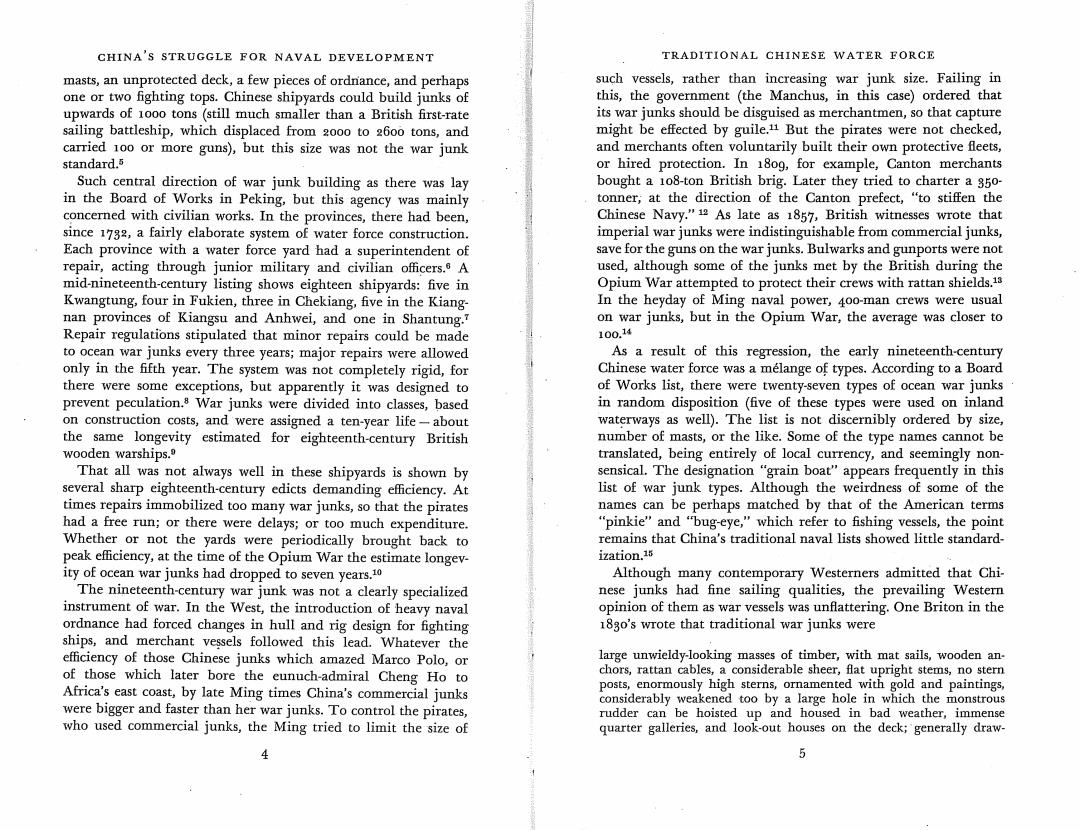正在加载图片...

CHINA'S STRUGGLE FOR NAVAL DEVELOPMENT TRADITIONAL CHINESE WATER FORCE masts,an unprotected deck,a few pieces of ordnance,and perhaps such vessels,rather than increasing war junk size.Failing in one or two fighting tops.Chinese shipyards could build junks of this,the government (the Manchus,in this case)ordered that upwards of 1o0o tons(still much smaller than a British first-rate its war junks should be disguised as merchantmen,so that capture sailing battleship,which displaced from zo00 to 2600 tons,and might be effected by guile.11 But the pirates were not checked, carried 1oo or more guns),but this size was not the war junk and merchants often voluntarily built their own protective fleets, standard.5 or hired protection.In 1809,for example,Canton merchants Such central direction of war junk building as there was lay bought a 108-ton British brig.Later they tried to charter a 850- in the Board of Works in Peking,but this agency was mainly tonner,at the direction of the Canton prefect,"to stiffen the concerned with civilian works.In the provinces,there had been, Chinese Navy."As late as 1857,British witnesses wrote that since 1732,a fairly elaborate system of water force construction. imperial war junks were indistinguishable from commercial junks, Each province with a water force yard had a superintendent of save for the guns on the war junks.Bulwarks and gunports were not repair,acting through junior military and civilian officers.o A used,although some of the junks met by the British during the mid-nineteenth-century listing shows eighteen shipyards:five in Opium War attempted to protect their crews with rattan shields.15 Kwangtung,four in Fukien,three in Chekiang,five in the Kiang- In the heyday of Ming naval power,4oo-man crews were usual nan provinces of Kiangsu and Anhwei,and one in Shantung.7 on war junks,but in the Opium War,the average was closer to Repair regulations stipulated that minor repairs could be made 100.14 to ocean war junks every three years;major repairs were allowed As a result of this regression,the early nineteenth-century only in the fifth year.The system was not completely rigid,for Chinese water force was a melange of types.According to a Board there were some exceptions,but apparently it was designed to of Works list,there were twenty-seven types of ocean war junks prevent peculation.War junks were divided into classes,based in random disposition (five of these types were used on inland on construction costs,and were assigned a ten-year life-about waterways as well).The list is not discernibly ordered by size, the same longevity estimated for eighteenth-century British number of masts,or the like.Some of the type names cannot be wooden warships. translated,being entirely of local currency,and seemingly non- That all was not always well in these shipyards is shown by sensical.The designation "grain boat"appears frequently in this several sharp eighteenth-century edicts demanding efficiency.At list of war junk types.Although the weirdness of some of the times repairs immobilized too many war junks,so that the pirates names can be perhaps matched by that of the American terms had a free run;or there were delays;or too much expenditure. "pinkie"and "bug-eye,"which refer to fishing vessels,the point Whether or not the yards were periodically brought back to remains that China's traditional naval lists showed little standard- peak efficiency,at the time of the Opium War the estimate longev- ization.15 ity of ocean war junks had dropped to seven years.10 Although many contemporary Westerners admitted that Chi- The nineteenth-century war junk was not a clearly specialized nese junks had fine sailing qualities,the prevailing Western instrument of war.In the West,the introduction of heavy naval opinion of them as war vessels was unflattering.One Briton in the ordnance had forced changes in hull and rig design for fighting 183o's wrote that traditional war junks were ships,and merchant vessels followed this lead.Whatever the efficiency of those Chinese junks which amazed Marco Polo,or large unwieldy-looking masses of timber,with mat sails,wooden an- of those which later bore the eunuch-admiral Cheng Ho to chors,rattan cables,a considerable sheer,flat upright stems,no stern Africa's east coast,by late Ming times China's commercial junks posts,enormously high sterns,ornamented with gold and paintings, were bigger and faster than her war junks.To control the pirates, considerably weakened too by a large hole in which the monstrous rudder can be hoisted up and housed in bad weather,immense who used commercial junks,the Ming tried to limit the size of quarter galleries,and look-out houses on the deck;generally draw- 4 5